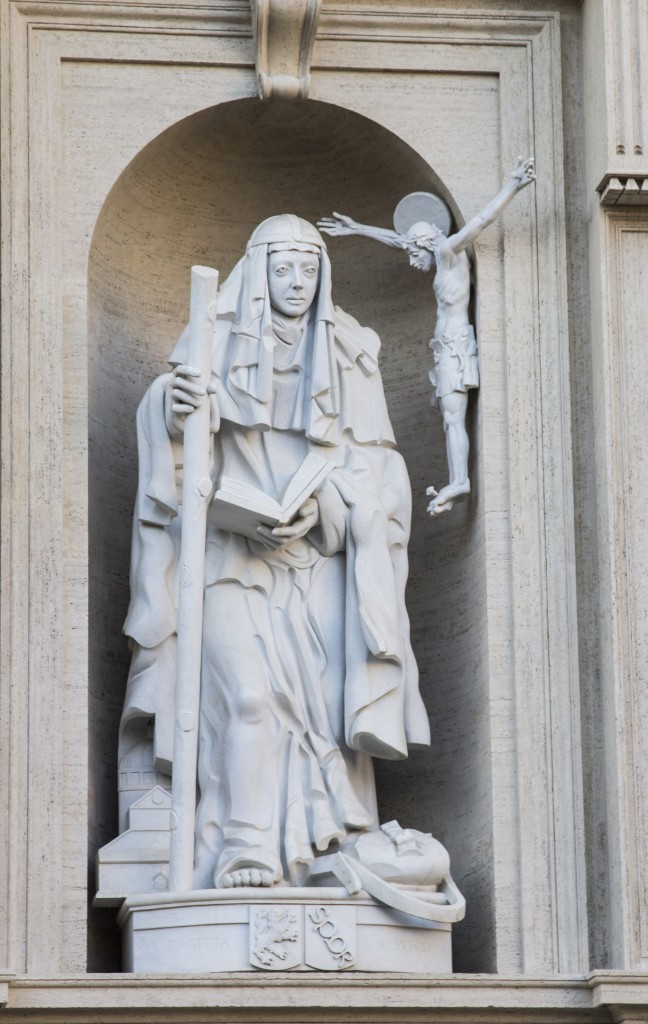July 23 is the feast day of Saint Bridget of Sweden. Pope Benedict XVI talked about her during a Wednesday audience in 2010.
1. She and her husband raised a saint (Catherine).
2. She and her husband, Ulf, show how “Christian spouses can make a journey of holiness sustained by the grace of the sacrament of Marriage.”
Bridget, who was given spiritual guidance by a learned religious who initiated her into the study of the Scriptures, exercised a very positive influence on her family which, thanks to her presence, became a true “domestic church”. Together with her husband she adopted the Rule of the Franciscan Tertiaries. She generously practiced works of charity for the poor; she also founded a hospital. At his wife’s side Ulf’s character improved and he advanced in the Christian life.
3. A little theology of women here:
It is often the woman, as happened in the life of St Bridget and Ulf, who with her religious sensitivity, delicacy and gentleness succeeds in persuading her husband to follow a path of faith. I am thinking with gratitude of the many women who, day after day, illuminate their families with their witness of Christian life, in our time too. May the Lord’s Spirit still inspire holiness in Christian spouses today, to show the world the beauty of marriage lived in accordance with the Gospel values: love, tenderness, reciprocal help, fruitfulness in begetting and in raising children, openness and solidarity to the world and participation in the life of the Church.
4. After 28 years of marriage, as a widow Bridget devoted herself to “prayer, penance and charitable works.”
5. “Bridget always had a special devotion to Christ’s Passion, contemplating in it God’s infinite love for human beings.”
6. He noted that St. JPII noted: “The Church, which recognized Bridget’s holiness without ever pronouncing on her individual revelations, has accepted the overall authenticity of her interior experience.”
7.
She boldly places these words on the lips of the Lord who speaks to her: “O my friends, I love my sheep so tenderly that were it possible I would die many other times for each one of them that same death I suffered for the redemption of all.”
8. “The sorrowful motherhood of Mary, which made her Mediatrix and Mother of Mercy, is also a subject that recurs frequently in the Revelations.”
9.
Bridget was aware that she had been given a gift of special love on the Lord’s part: “My Daughter” — we read in the First Book of Revelations — “I have chosen you for myself, love me with all your heart… more than all that exists in the world.” Bridget, moreover, knew well and was firmly convinced that every charism is destined to build up the Church.
10.
Bridget’s holiness, characterized by the multiplicity of her gifts and the experiences that I have wished to recall in this brief biographical and spiritual outline, makes her an eminent figure in European history. In coming from Scandinavia, St Bridget bears witness to the way Christianity had deeply permeated the life of all the peoples of this Continent. In declaring her Co-Patroness of Europe, Pope John Paul II hoped that St Bridget — who lived in the 14th century when Western Christianity had not yet been wounded by division — may intercede effectively with God to obtain the grace of full Christian unity so deeply longed for.
(Photo from outside St. Peter’s in Rome, via Fr. Lawrence Lew, O.P.)
St. Bridget of Sweden, pray for us.












